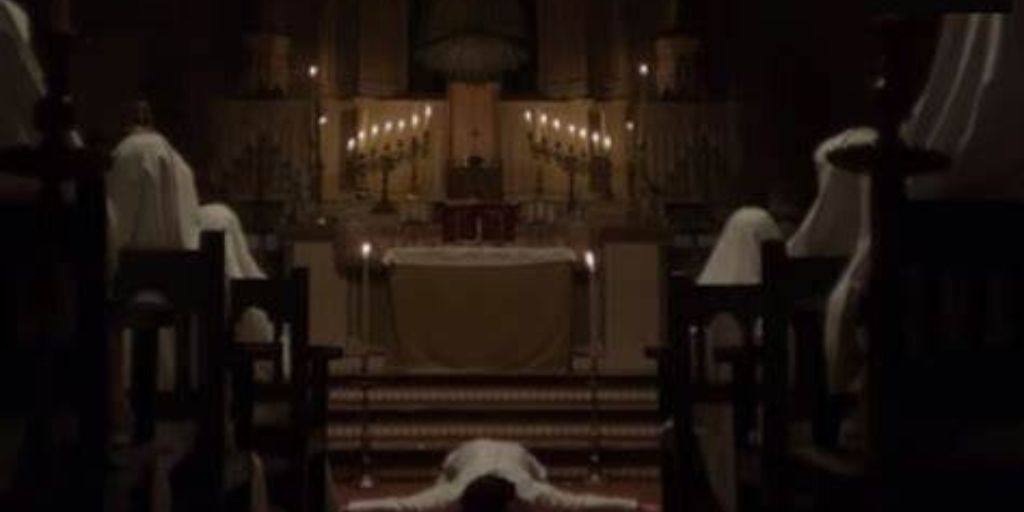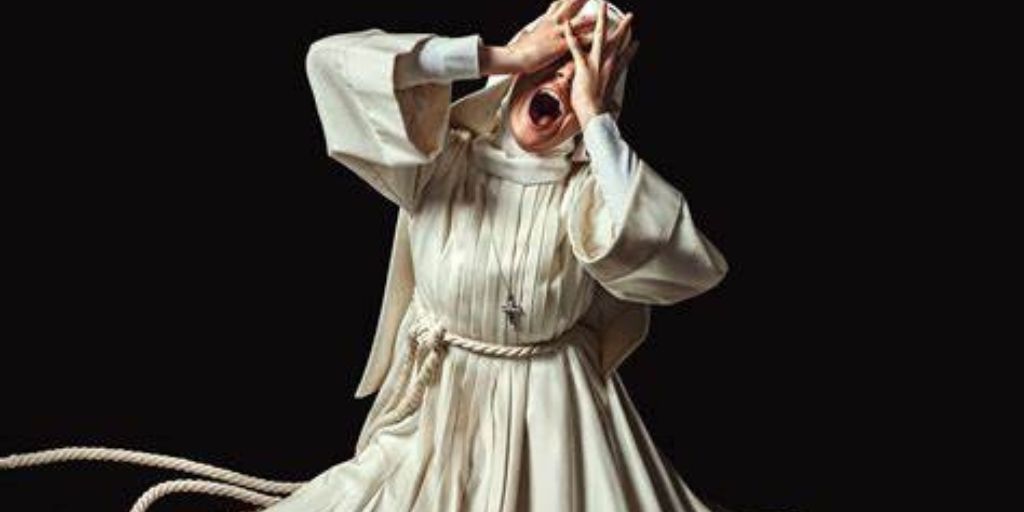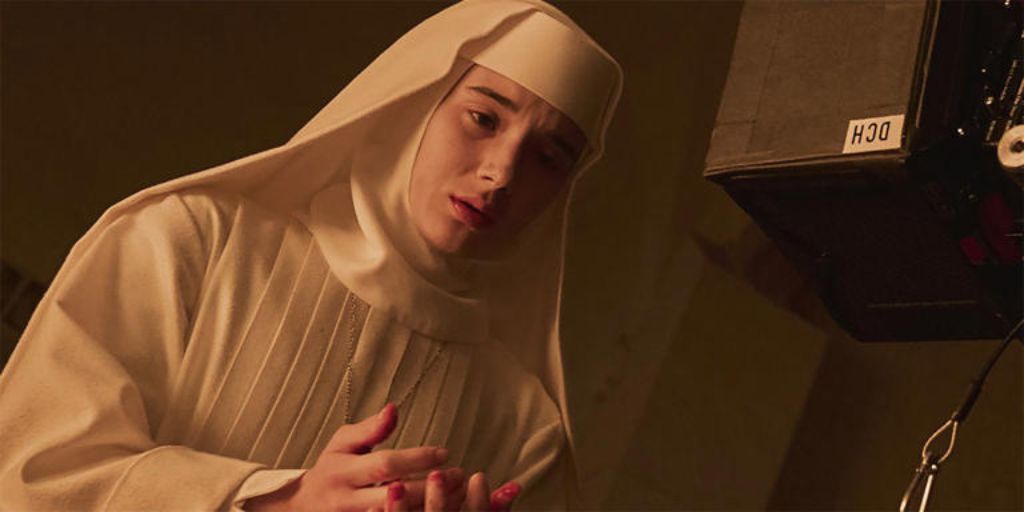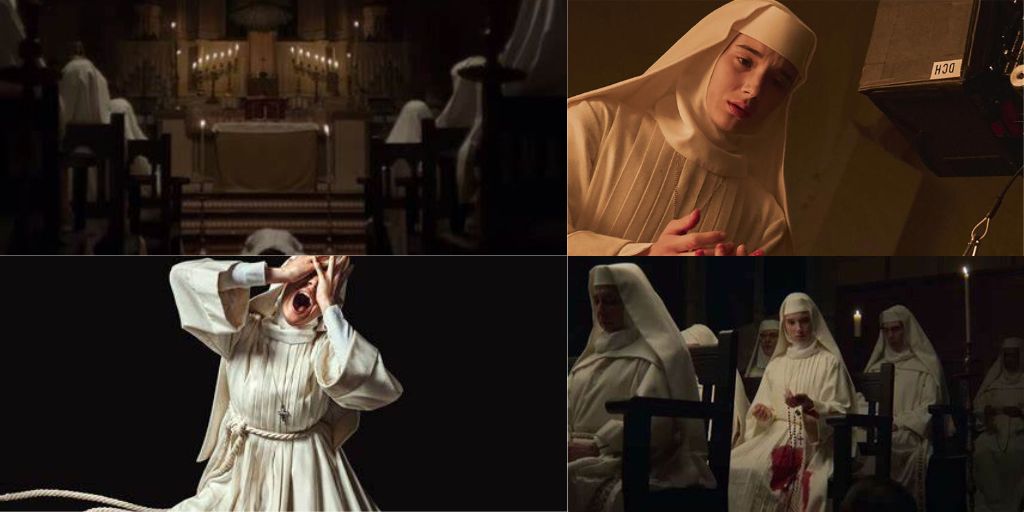Sister Death, a Netflix original film directed by Paco Plaza, is a loose prequel to the streamer’s 2017 sleeper hit Veronica. The film chronicles the tale of the peculiar Sister Narcisa, who is initially seen in Veronica as an unsettling figure known as “Sister Death.”
Sister Narcisa is portrayed by Aria Bedmar in her younger years and by Consuelo Trujillo in her senior years. In the first film, Sister Death, an old blind lady, is merely a jump scare that gives Veronica (Sandra Escacena) some unsettling counsel after she summons several demonic spirits while playing an Ouija board game.
Little more than a cameo, this one-shot moment was enough to spark many fans’ imaginations and earn Sister Death a feature film of her own. We discover the history of the eerie nun and her initial encounter with the afterlife in this new production.
Sister Death’s very last moment is reminiscent of Veronica. It shows an elderly Sister Narcisa accepting an invitation to give a speech to a group of young girls in her classroom. Veronica, one of these girls, gets distracted by a friend who addresses Narcisa as “Sister Death” the moment she sets eyes on her.
The nun’s appearance is the primary factor, as the girls perceive her as not only elderly and visually impaired but also terminally ill. They are unaware of Sister Narcisa’s life narrative, which Sister Death gives us access to, which is highly worthy of her nickname.
Sister Death’s Ending Explained
The narrative of Sister Death starts in 1939, during the last stages of the Spanish Civil War, which would lead to Francisco Franco’s dictatorship. The child Narcisa (Ainoa Hernández) in a little village has visions of Saint Mary, the mother of Jesus, which earns her the nickname “Holy Girl of Peroblasco.”
A decade later, Narcisa reappears, this time as a young novice enrolling in a convent that doubles as a school for underprivileged young girls. The Mother Superior (Luisa Merelas) greets Narcisa with wide arms and says they are fortunate that the Holy Girl will take her last vows among them.

They are unaware, though, that Narcisa is having a spiritual crisis and finds it difficult to accept that what she witnessed as a young kid was a manifestation of Our Lady. Narcisa begins to question her views more and more as she comes to understand that the convent is keeping something from her.
She discovers a portrait of Sister Socorro (Almudena Amor), a deceased nun, in her room. Whenever she stares at it, it appears to cause a chair to topple over. The walls are covered with strange, incomplete pictures of a hanged man, and marbles emerge out of nowhere, seemingly begging Sister Narcisa to play.
In addition, the young nun experiences terrifying nightmares whenever she does fall asleep, and she is awakened at night by loud knocks on her door. Even though their actions frequently suggest that something is amiss, the other nuns seem to be unaware of what is going on.
But the girls Narcisa teaches have a theory about why unusual things happen in the monastery. They allege that the location is haunted by the ghost of a girl who is roughly their age. If the ghost writes your name, it can steal your life, and you should never play her games unless you want to die.
However, upon reporting these tales to her superiors, Narcisa is informed that the girls only lack self-control, and she is even charged with fabricating events to reclaim her childhood notoriety. The character Sister Julia (Manu Valdivielso) even goes so far as to say that she is working with the devil.

The situation worsens to the point where the girl’s spirit writes Rosa’s (Sara Roch) name—a student for whom Narcisa has developed a special affection—on the chalkboard to announce her impending death. Rosa is horrified, but Sister Narcisa consoles her and asks for assistance in speaking with the spirit. The girl in Narcisa’s room finishes the drawing they started together, but she doesn’t approach.
Rosa informs Narcisa that, despite her insistence that no one is nearby, a woman’s ghost is standing directly behind her. Rosa is terrified by something that the ghost tells her, and she flees the room, disappearing. Narcisa, bewildered and in a frantic state, asks Rosa’s sister, Elvira (Olimpia Roch), for assistance in finding her, but it’s too late: Rosa’s body is found hanging in the confessional of the church.
Narcisa chooses to leave the convent because Sister Julia holds her responsible for the little girl’s demise. A few scenes earlier, Narcisa had taught the girls about a solar eclipse, which occurs when the moon covers the sun as she leaves the convent.
Narcisa is pulled to the sky even though she warned her students not to look straight at an eclipse. She is blinded by the odd light right away, but it also makes the secrets the convent has been trying to hide clear. Narcisa discovers what transpired at the convent and who the child is that has been haunting its residents as she is on her knees and looking up at the sky.

In one of Narcisa’s visions, Republican soldiers who opposed Franco were stationed at the monastery during the conflict. Before her eyes, there are alternating scenes of the men demolishing saints’ icons and taking the other nuns hostage until one of the soldiers is seen raping a woman.
That woman is none other than Sister Socorro, who became pregnant after experiencing abuse and gave birth to a daughter inside the convent’s walls. The other nuns decided that the girl would never be permitted to leave the institution.
This becomes problematic when Daniela Casas, the girl, gets sick, and Socorro demands that she be brought to the hospital. In an attempt to heal Socorro’s daughter, the other nuns take her away after refusing to accept her. They attempt to lower the child’s fever by giving her a cold bath, but their harsh handling and disregard for safety cause the kid to bump her head on the tub.
The girl, covered in blood, passes away. Socorro hangs herself after being devastated by the loss of her daughter. Narcisa’s chair kept falling to the floor because Socorro was kicking it, which allowed her to eventually pass away. Regarding the loud knocks on the door, those were Socorro’s frantic attempts, while confined to her room, to retrieve her kid.
Narcisa is saved from all of this after seeing it all by the sisters, who take her back to the monastery and tend to her burned eyes. But now that she knows the truth, she is unable to remain silent. Sister Socorro’s ghost, who has been knocking on the door for nearly ten years, is released by the Mother Superior after she confronts her about what transpired in the convent during the war.
In the process, she also releases Socorro from the past, and the ghost exacts revenge on Mother Superior by making her cough up blood in the present and drowning her in the tub full of her daughter’s blood in the past. Regarding Sister Julia, she is affected by pictures of damaged saints from both periods. Is this indicative of time travel? Well, not really, no.
The most accurate reading of this moment is that Narcisa destroyed the history the sisters had created for themselves by discovering the truth and revealing it. Of course, this has a theme. The sisters are slain by exactly what they were trying to hide—the broken saints stand in for the convent’s tragic past, and the girl’s drowning in the bathtub represents the girl’s death.

In terms of the plot, however, Socorro’s retribution should be viewed as operating on a spiritual plane; as a ghost, she is limited to acting on the past, but her choices have an impact on the present. Sister Death explores Narcisa’s crisis of faith as a major theme, akin to the unearthing of history.
It’s also safe to assume that she overcame it in some way because she continued to be a nun until Veronica’s time. However, what precisely does Sister Death’s conclusion reveal about Narcisa’s worldview? Images of what Narcisa saw as a little child in Peroblasco are presented to us before we go to Veronica’s school.
Alternatively, the first thing that is presented to us is Narcisa magically seeing Socorro in the convent’s washroom, her infant in her arms, surrounded by a brilliant light. Then, we go back to Narcisa’s early years, and we see the picture of Socorro and her daughter again, this time with the same vintage effect that the film used for 1939.





